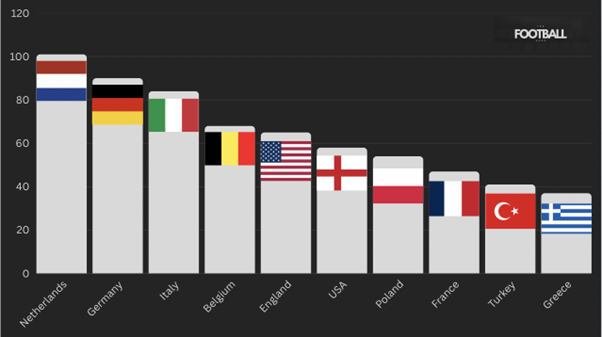Zlatan Ibrahimović, Erling Haaland, Alexander Isak, Lucas Bergvall, and Rasmus Højlund, just a few names that highlight the growing wave of talent emerging from the Scandinavian football market. These players, all developed and exported by Scandinavian clubs, have gone on to make major impacts on the European stage. But it wasn’t always this way. As recently as a few years ago, Scandinavia wasn’t seen as one of Europe’s prime talent pools.
In the 2019/20 season, a total of 174 players from Sweden, Denmark, Norway, Finland, and Iceland made permanent moves to clubs outside the region. By the 2023/24 season, that number had grown to 285, a 64% increase. So, what’s behind this increase? What makes the Scandinavian market so attractive, and which markets are these players going to?
Club Ownership Structures: A Development-Focused Model
One key factor is the unique ownership structure of many Scandinavian clubs. In Sweden, Norway, Finland, and Iceland, football clubs generally follow the 50+1 rule, meaning the majority of voting rights must be held by club members, usually the fans. This limits the power of private investors and prioritizes long-term sustainability and development over short-term profit.
Denmark, however, stands out as the exception. It allows full private ownership, which has led to significant investment in clubs like Brøndby IF, owned by Global Football Holdings and FC Midtjylland, formerly backed by Matthew Benham, who also owns Brentford FC. This contrast in ownership models has influenced each country’s approach to player development and recruitment.
Developing Talent from Within
Without access to large financial resources, most Scandinavian clubs rely heavily on their academies and internal development programs. Rather than spending heavily on star players, they invest in identifying, training, and promoting young talent.
Scandinavian clubs are also known for scouting within their own region, often signing players at low cost, developing them through structured programs, and selling them on to larger clubs. Notable talent-producing clubs include IF Brommapojkarna, Djurgårdens IF, Malmö FF, and AIK Fotboll.
These clubs consistently give young players meaningful first-team opportunities. For example, 18-year-old Bleon Kurtulus has started every match this season for Halmstads BK, gaining valuable top-flight experience and attracting international attention.
Another reason for the rise in exports is greater visibility through UEFA competitions. Clubs like Malmö FF, Bodø/Glimt, FC Copenhagen, and Midtjylland have participated more frequently in the UEFA Champions League and Europa League group stages over the past decade. These appearances offer international exposure for young players and allow scouts from top clubs to evaluate them against stronger competition.
When a Scandinavian club performs well in Europe, like Bodø/Glimt’s impressive run in the Europa competitions, it signals that their talent is capable of competing at a higher level.
Similarly, the academies of clubs in Denmark such as FC Copenhagen have always been at the forefront of recruiting players from a young age both in Scandinavia and from abroad and competing on a higher level. An example of this would be Roony Bardghji, transferring from Sweden to Denmark, getting appearances in the UEFA Champions League and now transferring to FC Barcelona. Sweden, in particular, benefits from a diverse population, with many young talents coming from the Middle East and the Balkans. Anel Ahmedhodžić, for instance, was born and raised in Malmö before making the move abroad to continue his career on a higher level.
Data-Driven Development and Coaching
One of the most impactful shifts in recent years has been the adoption of data and performance analytics across Scandinavian football. Clubs are increasingly using advanced metrics to scout players, design training programs, and improve tactical decision-making. Danish clubs such as FC Midtjylland have been at the forefront of this movement, implementing data models to identify undervalued players and optimise match preparation.
This analytical approach has created a smarter development environment, allowing Scandinavian clubs to compete intellectually, even if they can’t always compete financially. As a result, players trained in these systems are tactically well-educated and adaptable, which are traits that appeal to clubs in bigger leagues.
Scouting Beyond Borders: The African Pipeline
In recent years, Scandinavian clubs have also found great success in scouting talent from Africa. Young African players are often brought into Scandinavian academies, where they benefit from high-quality coaching, strong infrastructure, and a clear pathway to the first team.
These players tend to adapt quickly and showcase their abilities early, catching the attention of scouts from top European leagues. Denmark has particularly embraced this strategy. FC Nordsjælland, through its “Right to Dream” program, has become a prime example of combining African scouting with structured player development.
Top Destinations for Scandinavian Football Talent
An analysis conducted on transfer data from 2019/20 to the 2025/26 season shows clear trends in the destinations of Scandinavian players. The top ten markets for exported talent include:

Among these, the Netherlands stands out as the most frequent destination, followed by Germany, Italy, Belgium, and the United States.
Why the Netherlands?
The Netherlands has become a natural landing spot for Scandinavian players for several reasons. First, the cultural and lifestyle similarities help players settle in quickly. The Dutch Eredivisie and Eerste Divisie is also known for prioritising the development of young talent, with clubs unafraid to give younger players significant minutes in competitive matches.
From a footballing perspective, the Dutch style focuses on technical ability, attacking play, and tactical intelligence, which aligns well with the type of training Scandinavian players receive. Furthermore, salaries in the Netherlands are generally higher than in Scandinavian leagues, making the move financially attractive.
There’s also a deeper connection between Dutch and Scandinavian football philosophies. Both regions emphasise player education, positional play, and responsibility on the pitch. In both systems, players are expected to be intelligent decision-makers, not just athletes. This similarity means Scandinavian players often require less time to adapt to Dutch football than they would in other leagues.
In addition, the Netherlands often serves as a proven stepping stone to Europe’s top five leagues, making it an appealing intermediate destination for ambitious players seeking upward mobility.
The rise of the Scandinavian football market is no accident. It’s the result of smart ownership structures, a strong focus on youth development, data-driven decision-making, effective international scouting, and increased exposure through European competition. Scandinavian clubs have built efficient systems that consistently produce talented, well-rounded, and tactically prepared players.
As more European clubs recognise the quality and value of this talent pool, Scandinavia is no longer just an under-the-radar region, it’s a vital part of the global football ecosystem, and one of the most exciting talent factories in the world today and its growth will continue in the football industry.

